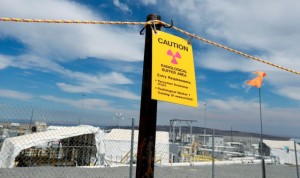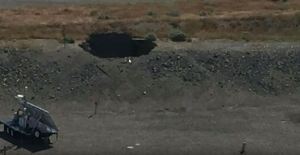nsnbc : Crews at the Hanford Nuclear Reservation in Washington state, USA, filled the hole left by a collapsed storage tunnel for highly toxic waste by dumping some 50 truckloads of dirt into the hole. The Department of Energy stresses that no release of radioactivity had been registered. Asked about specific information about the methodology used to determine whether or not leaks had occurred, the department replied that this information was not readily available.
 By late Wednesday night crews at the Hanford Nuclear Reservation had filled the hole in storage tunnel no. 1 at the PUREX site. Having filled the hole ends the immediate threat of a release of radiation, radioactively contaminated materials and radioactive isotopes into the atmosphere. Crews had dumped 53 truckloads or about 550 cubic yards of sand and soil in the tunnel using an excavator with a scoop. An emergency declaration was lifted when the work was completed.
By late Wednesday night crews at the Hanford Nuclear Reservation had filled the hole in storage tunnel no. 1 at the PUREX site. Having filled the hole ends the immediate threat of a release of radiation, radioactively contaminated materials and radioactive isotopes into the atmosphere. Crews had dumped 53 truckloads or about 550 cubic yards of sand and soil in the tunnel using an excavator with a scoop. An emergency declaration was lifted when the work was completed.
The PUREX plant was used starting in 1956 to chemically process irradiated uranium fuel to remove plutonium for the United States’ nuclear weapons program during the Cold War. Between 1960 and 1965, eight rail cars holding highly contaminated equipment from the plant were pushed into the tunnel and left. A second, longer tunnel attached to the first was built in 1964 for additional waste. Permits for and inventories from the tunnels reveal that the waste contains “extremely toxic” materials. The newer tunnel had more robust construction, with internal steel I-beams attached to reinforced concrete arches. Both were sealed.
The cause of the collapse of part of the ceiling in tunnel no. 1 hasn’t yet been determined. It is also possible that the hole was open for several days before it was discovered. Destry Henderson, spokesman for DOE contractor CH2M Hill Plateau Remediation Co. said no cause for the collapse has been determined, “Our focus remains on near-term protective actions. … They won’t take place until we’re sure we can do it safely.”
 To meet the state order the risks of possible additional failures to either of the PUREX waste tunnels must be assessed by July 1. Additional deadlines set by the state will require Department of Energy (DoE) to develop a plan to ensure the safe storage of waste in both tunnels and to submit a plan for permanently cleaning up the waste in the tunnels. Energy Secretary Rick Perry said Thursday that the DoE now has to figure out how to prevent any further collapses at the two tunnels holding highly radioactive equipment at the defunct PUREX plant in central Hanford. “Our next step is to identify and implement longer-term measures to further reduce risks,” he said.
To meet the state order the risks of possible additional failures to either of the PUREX waste tunnels must be assessed by July 1. Additional deadlines set by the state will require Department of Energy (DoE) to develop a plan to ensure the safe storage of waste in both tunnels and to submit a plan for permanently cleaning up the waste in the tunnels. Energy Secretary Rick Perry said Thursday that the DoE now has to figure out how to prevent any further collapses at the two tunnels holding highly radioactive equipment at the defunct PUREX plant in central Hanford. “Our next step is to identify and implement longer-term measures to further reduce risks,” he said.
The Department Energy claimed that no release of radioactivity has been discovered. nsnbc contacted the DoE, convinced that our readers and the general public would appreciate more specific information about the methodology used to determine whether or not the tunnel collapse caused releases of radioactive materials.
 In an email to the DoE we asked if the DoE could tell us:
In an email to the DoE we asked if the DoE could tell us:
“Exactly, what methodology was used to determine possible leaks of radioactive isotopes from the tunnels in question? What was measured, using what type of instruments, at which locations?
Yvonne Levardi sent a polite standard reply that did not even begin to answer our question. Yvonne Lavardi wrote in her standard “cut and paste reply”:
Hi Christof. .. Please see below to answer your questions. Best, Yvonne … The material buried in PUREX tunnel one is failed equipment from PUREX operations. The tunnel was filled to capacity as of January 1965. The closed tunnel is below ground, with about 8 feet of soil covering it. The soil, in addition to the tunnel itself, serves as shielding. … The Department and its contractor are monitoring for potential release of contaminants, with radiation technicians on site. These technicians are equipped with sampling and monitoring equipment, which allow them to take air and surface samples. There have been no indications of any release at this time.
Not so easily detracted and still convinced that our readers expect more specific answers from the Department, we tried again and wrote back to Yvonne:
“Thanks for your swift reply. We have copies of the lists with materials stored in tunnels 1 and 2. Our question is – what methodology is used to sample air and surface samples, with what kind of instruments, in which locations? I hope that this clarified our questions. It sounds good that there has been no indication of a release at this time, but understandably, whether or not such indications would be discovered, even if there was a release, depends on the above mentioned. .. Looking forward to more detailed information and keeping my fingers crossed for all of you who are trying your best there at the reservation. W.r. Christof”
See, we are having some serious fun already. Who said journalism needs to be boring. Yvonne, apparently taken aback by our nosy newspaper replied:
“Hi Chris. Can you please clarify. Are you asking for us to give you make and model of the radiation detection and monitoring equipment that our radcon techs are using? Because we don’t have that information readily available. – Best, Yvonne.
So, this author was thinking “Yvonne, our readers will come to love you, because you finally understand at least part of our rather simple question. So we gave Yvonne yet another explanation and sent her an email stating:
“Yvonne… Thank you. When we have nuclear engineers, environmental engineers and other experts review such cases – beyond the level of press releases – we do of course need to know * What instruments you are using (not necessarily make or model – technical details would be a good addition and/or substitute). * How many of such instruments are in use to monitor the current situation? – * Where such instruments are located / measurements are taken (geographical location, dispersion as well as temporal and spatial dispersion of instruments and measurements). … It believe it goes without saying that methodology has an impact on the outcome? .. I hope that this clarified our “preliminary” questions, and we are looking forward to staying in touch. W.r. etc.. “
We will of course keep our readers informed about the answer(s) if and when they come, to then determine whether the statement that there was no “registered” release may have been correct because of sheer luck, or if it is likely that no release was registered, because it really is difficult to find something that you aren’t really looking for.
CH/L – nsnbc 12.05.2017
Source Article from https://nsnbc.me/2017/05/12/hanford-doe-claims-about-environmental-safety-based-on-not-readily-available-information/
 RSS Feed
RSS Feed















 May 12th, 2017
May 12th, 2017  Awake Goy
Awake Goy 










 Posted in
Posted in  Tags:
Tags: 













